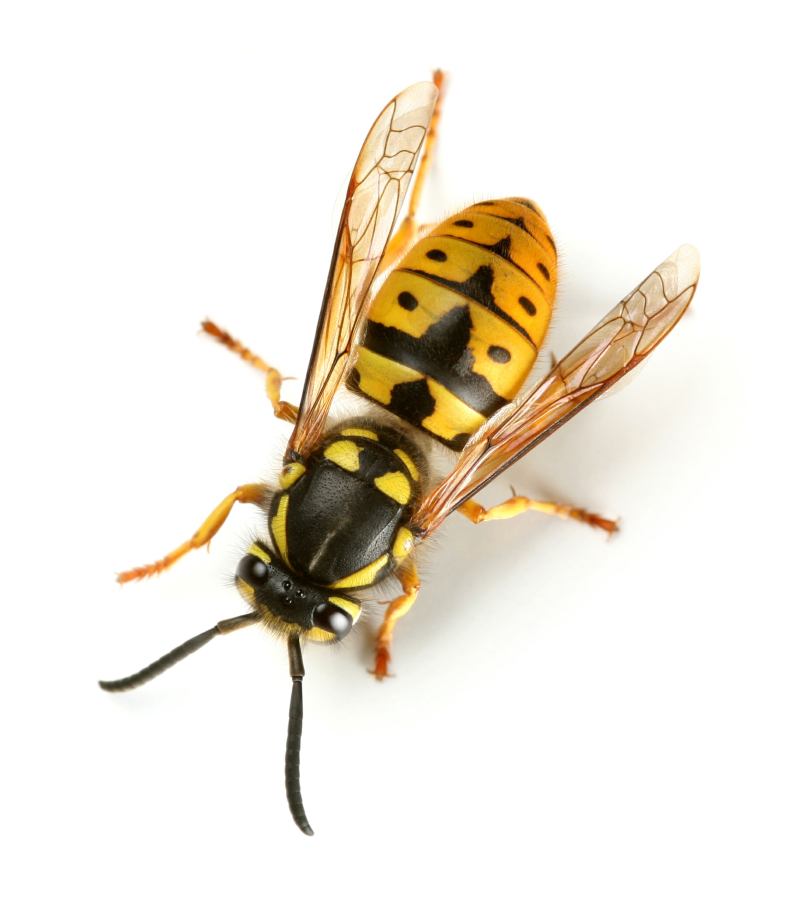EUGENE — As a gardening expert, Jeff Choate can tell you that the combination of a dry spring and hot summer this year have spurred a rise in the number of yellow jackets.
As a guy with country property in the Mohawk Valley northeast of Eugene-Springfield, he can tell you about the dangers of unintentionally disturbing yellow jacket nests.
“I got stung two weeks ago and a week before that,” said Choate, a horticulturist for the Oregon State University Extension Service in Lane County. “I’ve been stung about once a weekend at least for the last three weeks. That’s what I get for working outside.”
Willamette Valley residents are seeing more yellow jackets in their gardens and yards, said Gail Langellotto, an entomologist — or insect scientist — with the OSU Extension Service in Corvallis. Water and food attract yellow jackets into gardens and yards.
“That’s where they are finding the things they need to continue to grow (their nests) and persist,” said Langellotto, who monitors 24 gardens in Portland. She has been in Oregon for about a decade, and this year the gardens have had more yellow jackets than normal.
Yellow jackets are a type of wasp, distant cousins of bees, that nest in the ground. They can be aggressive, particularly if and when people disturb their nests, Choate said. While bees can only sting once, with a stinger that stays in their victim, yellow jackets are capable of stinging again and again and injecting venom each time. (Yellow jackets also can bite, but without venom.)
Yellow jackets also are well known for crashing picnics and barbecues. The insects are scavengers, searching for food to bring back to yellow jackets in the nest, so they go after meat. Anyone trying to eat a chicken drumstick or burger outside, beware.
Colonies of yellow jackets will keep growing through the rest of the summer and into fall, Langellotto said, and each nest might number in the thousands of insects. Langellotto, like Choate, said weather conditions have contributed to the boom in yellow jackets this year. Due to all the thriving nests, risk of being stung by a yellow jacket is high.
Choate said his most recent encounter with yellow jackets left him with four or five stings on his ankle. He isn’t alone when it comes to a painful story.
Gavin Roberts, 36, was stung 15 to 20 times by yellow jackets in his own back yard off River Road. He had just come back from the Oregon Country Fair in mid-July and found that a soaker hose in his garden had broken near his raspberry patch.
“Suddenly, I started feeling this kind of burning sensation on my leg and I look down and I just have a cloud of yellow jackets around me,” he said. “So I started running toward the house and brushing them off with my left arm … and they started moving onto my arm, too.”
He began to swell up and develop hives after the attack. He went to urgent care, where he was treated for the allergic reaction. “It was a little scary, and definitely painful,” he said.
Roberts, who has lived in Eugene since 1991, said there seems to be “way more” yellow jackets than normal. He found three nests alone in his backyard. He tried to kill the insects with a pesticide, but two of the nests came back.
“It’s pretty clear that it’s abnormal this year,” Roberts said.
For the Grishkin family of Eugene, the summer’s sting tally so far is 16. Julie Grishkin, 35, said the older of her two daughters has endured most of the yellow jacket stings, having been stung while camping at the coast and in her own back yard.
“She has just been unlucky,” Grishkin said. “I think she just smells really nice and they like her.”
Earlier this month, Grishkin was stung twice herself while at Dexter Lake. She was helping a friend pump up an inflatable stand-up paddle board and a yellow jacket flew between her foot and her sandal. Grishkin suffered swelling, like Roberts, from an allergic reaction and had to stay off her feet for four or five days.
The experiences have made the whole family leery of the insects.
“They’re horrible, we can’t even eat outside in the back yard because they just immediately come over and try to get on our food,” Grishkin said.
Even though yellow jackets can be stinging menaces, they can also be good for gardens by preying on caterpillars, flies and spiders.
“If it weren’t for yellow jackets this time of year, who knows how many insect pests we might have to contend with,” Choate said.



